|

Listing: Locally listed in 2004. Main entrance to Bilston Cemetery.
Consists of main vehicle entrance and one pedestrian entrance to the left with
elaborate wrought iron gates. Three blue brick piers with buff stone
dressings and caps and associated flanking walls. Cemetery opened 1855.
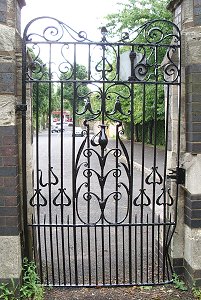 |
Comment: George T. Lawley's "A History of
Bilston", 1893, says that "in 1854 (May 2nd) the foundation stone of the
Cemetery Chapel was laid by James Loxdale Esq., and the grounds were
open for internment on March 9th, 1855. The cemetery area contains
9 acres, 2 roods, 23 poles, and the total cost was about £5,000.
The chapel is built of the best blue bricks and the grounds are
tastefully laid out".
The Cemetery Chapel no longer exists but was presumably built out of
the same blue bricks as the gateway, probably with similar stone
dressings.
The gate to the pedestrian entrance is shown left. The main gates are
in a similar style. Whatever the date of the piers, can the gates
themselves really be 1855? |
Although Lawley does not mention it, the cemetery was entirely the work of
the Bilston Town Commissioners. They were originally established under
an Act of 1824 and had had passed an Act of 1850 which authorised them to
carry out several improvements in the town including the creation of this
cemetery.
The "Supplement to the Wolverhampton Chronicle" of 22nd November 1854,
carries a report of the monthly meeting of the Town Commissioners. This
shows that the architects for the whole scheme (presumably including these
gates) were Messrs Bidlake and Lovatt, the surveyor was a Mr. Marten, and the
contractors were Messrs, Burkitt and Nelson. The Commissioners passed a
resolution expressing their satisfaction with the efforts of all of these people
and with the progress made so far. The Commissioners also met a Mr. Ward,
who had a lease on the coals under a part of the cemetery grounds, and decided
to postpone a decision on whether or not he could have an extension of the time
allowed him to finish winning the coal. They also had a communication from
the Rev. Davis, the Roman Catholic Priest, who said that there were 10,000
Catholics in Wolverhampton and Bilston at that time. Father Davis pointed
out that the Act allowed the Commissioners to set aside parts of the cemetery
for family or denominational use. He wanted them to set aside a part for
exclusive Roman Catholic use and to allow a wall to be built around that part.
The Commissioners were strongly against any such wall, pointing out that the
part they had already set aside for the Church of England was defined only by a
path. But the decision on the general principle was postponed until the
next meeting.
In Samuel Griffith's "Guide to the Iron Trades of Great Britain" (first
published in 1873), Griffiths, who was a local man with interests in both
Bilston and Wolverhampton, described the journey from Bilston to Wolverhampton:
Leaving Bilston then by the highway, we pass the Cholera Orphanage and on
the right, observe a little farther on, the Bilston Cemetery, which, to a
stranger, has a very singular appearance, although well looked after.
Situated on the very top of the old mines, the land all round for miles is
devastated and thrown into heaps. Attempts have been made to level the
ground and recultivate the surface, but nature, after the torture which she
has undergone, refuses to give her increase; the trees all withered away,
the sun appears to frown on the efforts of man, and refuses to force his
genial, sparkling rays through the murky atmosphere which enshrouds this
devoted spot. At night the distant dim lights throw their ghastly
flickerings over the graves and tombstones of this disembowelled necropolis,
rendering the place a source of solemn reflection to the midnight traveller,
and of melancholy contemplation to a cluster of inhabitants who dwell in the
precincts of the dead.
Now the industrial smog has gone and the cluster of inhabitants has been
replaced by suburban streets. Surprisingly, for a cemetery apparently
built on old coal workings, there appears to be no subsidence in the cemetery
and what was a disembowelled necropolis is now a neat and orderly place.
| The cemetery does not contain any very large
monumental piles. The one shown right is one of the few large
ones. Many of the men who made the most money out of Bilston -
even the Sankeys, who took an active part in Bilston's community
life - went and lived elsewhere and that was where they were buried.
But there is a wide range of smaller Victorian monuments (as well
as many of a later date up to the present) on which are the names of
many well known Bilston families. |
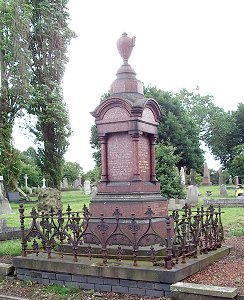 |
 |
However some of the local industrialists are here.
This is the grave of Samuel Edge who owned the Forward shoe factory
and was in business in a big way.
This memorial was originally
erected for his first wife, Naomi, in 1934. It is said that it
was so sited as to be visible from Samuel's office window.
Although he later married again he asked to be buried here with his
first wife. |
| This red granite Celtic cross marks the family plot of
Thomas Wood, who is recorded on the stone as being a JP; but it does
not mention that he had been Mayor of Bilston and was the proprietor
of the famous Wood's Palace, Bilston's main cinema. |
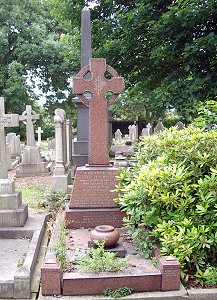 |
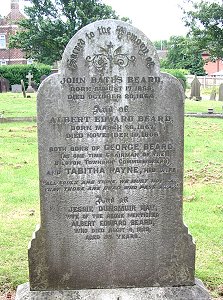 |
Although the Wood memorial does not mention his
commercial or civic achievements there are, perhaps, more memorials
that do mention civic activities than is usual - Bilston had a
strong sense of its own identity and a strong civic pride. This memorial to Albert Edward Beard records that he as once the
Chairman of the Town Commissioners, who were the predecessors to the
Bilston Urban District Council and the Bilston Borough Council
who built this cemetery. |
| A more curious example of civic action is this (now
slightly askew) headstone which records that Walter Hughes was "for
more than twenty years the sanitary inspector of Bilston. His
upright conduct and genial manner earned for him the deep regard of
all his fellow towns-people". Bilston came late to the idea of
sanitation and the Cholera Visitation of 1832 caused terrible loss
of life. Hughes must have been an important figure in the
consequent improvements to the town's drainage and sanitation. |
 |
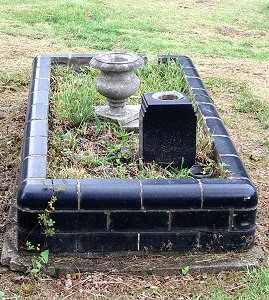 |
The cemetery contains a number of graves marked by
black glazed brick surrounds like this. Their date is unknown
but they do not seem to be present elsewhere in Bilston or
Wolverhampton.
It is curious that St Leonard's has its
(almost) unique cast iron grave slabs, St, Mary's has its (possibly
unique) barrel shaped stone grave slabs, and the Cemetery has these. |
| This grave, of a twenty year old woman, is entirely made of wood
(the cross at the foot is stone and seems to be a later addition). The reason for the use of this unusual material is not known.
It seems to be unique and to have been well done. Perhaps the
bereaved father was a wood carver. |
 |

|